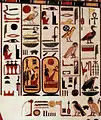| ||||||||
| Water jugs in stand in hieroglyphs | ||||||||
|---|---|---|---|---|---|---|---|---|

Relief with 3- and 4-jug hieroglyphs.
Wikimedia Commons has media related to Vases with support (hieroglyph).
The ancient Egyptian Water-jugs-in-stand hieroglyph, is Gardiner sign listed no. W17, W18, within the Gardiner signs for vessels of stone and earthenware.
The hieroglyph is used as an ideogram in (kh)nt-(ḫnt), for 'a stand (for vases)'. It is also used phonetically for (ḫnt).[1]
Egyptian "khenti"
The water-jugs-in-stand hieroglyph is often written with the complement of three other hieroglyphs, the water ripple,
, bread bun,
, and two strokes,
, to make the Egyptian language word foremost, khenti. The complete composition block is:
As Egyptian "khenti",[2] foremost is used extensively to refer to gods, often in charge of a region, or position, as foremost of xxxx. Anubis, or Osiris are often referred to as "Foremost", or "Chief" of the 'western cemetery', (where the sun sets).
 Relief from the limestone sarcophagus of Ashayet, 11th Dynasty
Relief from the limestone sarcophagus of Ashayet, 11th Dynasty
 Relief
Relief Painted Relief
Painted Relief
See also
References
- Betrò, 1995. Hieroglyphics: The Writings of Ancient Egypt, Maria Carmela Betrò, c. 1995, 1996-(English), Abbeville Press Publishers, New York, London, Paris (hardcover, ISBN 0-7892-0232-8)
- Budge. An Egyptian Hieroglyphic Dictionary, E. A. Wallis Budge, (Dover Publications), c 1978, (c 1920), Dover edition, 1978. (In two volumes) (softcover, ISBN 0-486-23615-3)
This article is issued from Wikipedia. The text is licensed under Creative Commons - Attribution - Sharealike. Additional terms may apply for the media files.